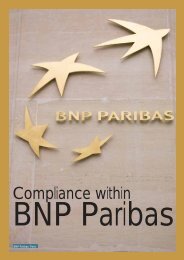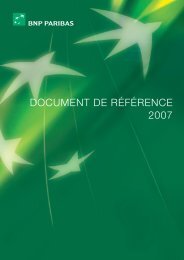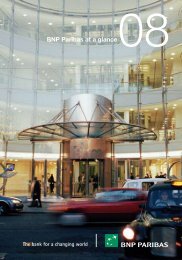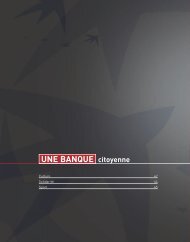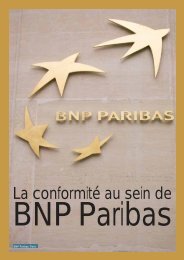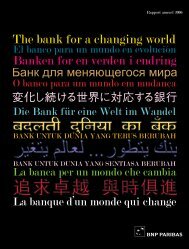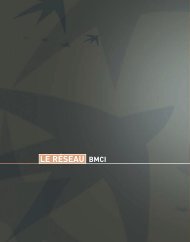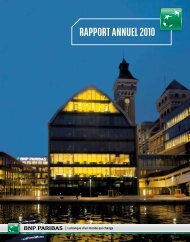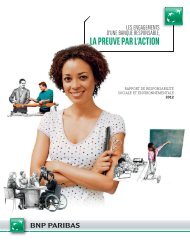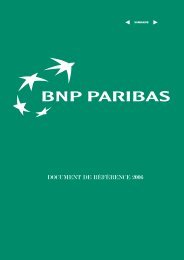2007 REGISTRATION DOCUMENT
2007 REGISTRATION DOCUMENT
2007 REGISTRATION DOCUMENT
- No tags were found...
Create successful ePaper yourself
Turn your PDF publications into a flip-book with our unique Google optimized e-Paper software.
5 NotesCONSOLIDATED FINANCIAL STATEMENTSto the financial s tatements p repared in accordance with I nternational Financial Reporting S tandards as adopted by the European Union< Contents >use of appropriate mortality tables (certified tables in the case ofannuity-holders), medical screening appropriate to the level of benefitoffered, statistical monitoring of insured populations, and reinsuranceprogrammes.Non-life technical reserves include unearned premium reserves(corresponding to the portion of written premiums relating to futureperiods) and outstanding claims reserves, inclusive of claims handlingcosts.The adequacy of technical reserves is tested at the balance sheet dateby comparing them with the average value of future cash flows asderived from stochastic analyses. Any adjustments to technical reservesare taken to the profit and loss account for the period. A capitalisationreserve is set up in individual statutory accounts on the sale ofamortisable securities in order to defer part of the net realised gainand hence maintain the yield to maturity on the portfolio of admissibleassets. In the consolidated financial statements, the bulk of this reserveis reclassified to “Policyholders’ surplus” on the liabilities side of theconsolidated balance sheet; a deferred tax liability is recognised on theportion taken to shareholders’ equity.This item also includes the policyholders’ surplus reserve resulting fromthe application of shadow accounting. This represents the interestof policyholders, mainly within French life insurance subsidiaries, inunrealised gains and losses on assets where the benefit paid underthe policy is linked to the return on those assets. This interest is anaverage derived from stochastic analyses of unrealised gains and lossesattributable to policyholders in various scenarios.1.d.3 Profit and l oss a ccountIncome and expenses arising on insurance contracts written by the Groupare recognised in the profit and loss account under “Income from otheractivities” and “Expenses on other activities”.Other insurance company income and expenses are included in therelevant profit and loss account item. Consequently, movements in thepolicyholders’ surplus reserve are shown on the same line as gains andlosses on the assets that generated the movements.1.e PROPERTY, PLANT AND EQUIPMENTAND INTANGIBLE ASSETSProperty, plant and equipment and intangible assets shown in theconsolidated balance sheet comprise assets used in operations andinvestment property.Assets used in operations are those used in the provision of services orfor administrative purposes, and include non-property assets leased bythe Group as lessor under operating leases.Investment property comprises property assets held to generate rentalincome and capital gains.Property, plant and equipment and intangible assets are initiallyrecognised at purchase price plus directly attributable costs, togetherwith borrowing costs where a long period of construction or adaptationis required before the asset can be brought into service.Software developed internally by the BNP Paribas Group that fulfilsthe criteria for capitalisation is capitalised at direct development cost,which includes external costs and the labour costs of employees directlyattributable to the project.Subsequent to initial recognition, property, plant and equipment andintangible assets are measured at cost less accumulated depreciation oramortisation and any impairment losses. The only exceptions are sharesin civil property companies (SCIs) held in unit-linked insurance contractportfolios, which are measured at fair value on the balance sheet date,with changes in fair value taken to profit or loss.The depreciable amount of property, plant and equipment and intangibleassets is calculated after deducting the residual value of the asset.Only assets leased by the Group as lessor under operating leases arepresumed to have a residual value, as the useful life of property, plantand equipment and intangible assets used in operations is generally thesame as their economic life.Property, plant and equipment and intangible assets are depreciatedor amortised using the straight-line method over the useful life of theasset. Depreciation and amortisation expense is recognised in the profitand loss account under “Depreciation, amortisation and impairment ofproperty, plant and equipment and intangible assets”.Where an asset consists of a number of components that may requirereplacement at regular intervals, or that have different uses or differentpatterns of consumption of economic benefits, each component isrecognised separately and depreciated using a method appropriate tothat component. The BNP Paribas Group has adopted the componentbasedapproach for property used in operations and for investmentproperty.The depreciation periods used for office property are as follows: 80 yearsor 60 years for the shell (for prime and other property respectively);30 years for facades; 20 years for general and technical installations;and 10 years for fixtures and fittings.Software is amortised, depending on its type, over periods of no morethan 8 years in the case of infrastructure developments and 3 years or5 years in the case of software developed primarily for the purpose ofproviding services to customers.Software maintenance costs are expensed as incurred. However,expenditure that is regarded as upgrading the software or extending itsuseful life is included in the initial acquisition or production cost.Depreciable property, plant and equipment and intangible assets aretested for impairment if there is an indication of potential impairment atthe balance sheet date. Non-depreciable assets are tested for impairmentat least annually, using the same method as for goodwill allocated tocash-generating units.If there is an indication of impairment, the new recoverable amountof the asset is compared with the carrying amount. If the asset isfound to be impaired, an impairment loss is recognised in the profitand loss account. This loss is reversed in the event of a change in theestimated recoverable amount or if there is no longer an indication ofimpairment. Impairment losses are taken to the profit and loss accountin “Depreciation, amortisation and impairment of property, plant andequipment and intangible assets”.Gains and losses on disposals of property, plant and equipment andintangible assets used in operations are recognised in the profit and lossaccount in “Net gain on non-current assets”.Gains and losses on disposals of investment property are recognised inthe profit and loss account in “Income from other activities” or “Expenseson other activities”.1234567891011124<strong>2007</strong> Registration document - BNP PARIBAS



